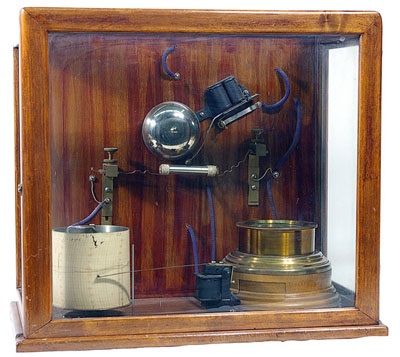Image: Popov1
Description: One of the first radio receivers, constructed by Russian engineer Alexander Stepanovich Popov in 1895 as a lightning detector. On May 7, 1895, he demonstrated the reception of radio pulses from a spark-gap radio transmitter. Along with Guglielmo Marconi, Popov shares credit for the invention of the radio receiver, and the first radio communication. May 7 is celebrated in as Radio Day in Eastern Europe. The device consists of a primitive radio wave detector called a coherer, a glass tube containing metal filings between two electrodes (center). The electrodes were connected to a suspended wire antenna and a ground connection. When a radio wave struck the antenna, the coherer would become conductive. The coherer was also connected to a DC circuit with a battery and a relay (metal cylinder, bottom right). When the coherer became conductive, current from the battery would turn on the relay, which would send current through an electromagnet to pull an arm over and ring a bell (upper center). When the clapper arm sprang back it would tap the coherer tube, jarring the filings, resetting it to its nonconductive state, making it ready for the next radio signal. The relay would also send a pulse to a chart recorder (white cylinder) which would make a mark on a chart paper, recording the occurrance. In 1896 Popov mounted the device on the roof of the Military Academy, and it recorded lightning strikes up to 50 km away.
Title: Popov1
Credit: http://www.viol.uz/history/chronicle/page12.shtml
Author: Unknown
Usage Terms: Public domain
License: Public domain
Attribution Required?: No
Image usage
The following 2 pages link to this image:


